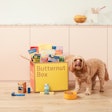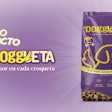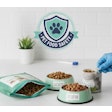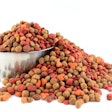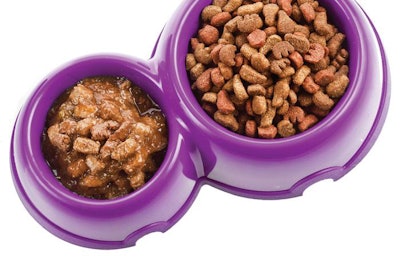
The factors that frame the most basic of commercial pet food choices, dry vs. wet, often get lost amid the attention paid to the proliferating and trendsetting formulation options: organic vs. conventional, superpremium vs. premium, grain-free or non-GMO vs. senior/weight management or digestive, wilderness vs. superfood/culinary, fresh vs. freeze-dried.
Nonetheless, pet parents bring a set of preconceptions and preferences to the decision between dry and wet pet food that frame product choices well before brand reputation, specialty formulations, or product claims or introductions kick in. Among these, two assumptions and one preference help give dry pet food a strong advantage, in keeping with its share of pet food sales.
Dry pet food assumptions: healthier, better for oral care
Given the long tradition of mass-market canned pet food strongly positioned on pet pampering and indulgence — particularly in the cat segment, where canned food has long straddled the divide between food and treat — pet owners generally believe that dry pet food is healthier. That is, nearly half of dog or cat owners (47–48 percent) at least somewhat agree that dry pet foods tend to be healthier, and nearly twice as many strongly agree as disagree with this premise, according to Packaged Facts survey data from February/March 2017, with dog owners only slightly surpassing cat owners in this conviction (see Table 1).

TABLE 1: A significant percentage of pet owners surveyed said that they believe dry pet food formulations tend to be healthier than wet or canned foods.
A similar but even sharper pattern holds for the related belief that kibble is healthier than canned pet food for oral care purposes, because the abrasion associated with chewing kibble helps clean pets’ teeth. Dog and cat owners are mostly split between strongly agreeing (at 49 percent vs. 44 percent, respectively) or somewhat agreeing (43 percent vs. 45 percent) that kibble is better for pet oral care, with only about one-tenth disagreeing with this premise, even though it is largely based on anecdotal evidence (see Table 2).
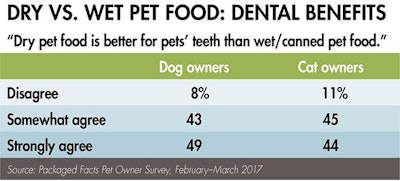
TABLE 2: More than 90 percent of dog owners and nearly 90 percent of cat owners “agree” or “strongly agree” that dry pet food is better for pets’ teeth than wet or canned pet food.
Dry pet food preferences: no odor
Alongside these pet health-centered convictions, and perhaps helping to keep them afloat, is a more self-interested pet owner preference for pet foods that aren’t overly odorous. While the pattern is less sharp on this question, less than a third of dog owners (28 percent) or cat owners (31 percent) are not put off by pet foods that have a strong smell. Among dog or cat owners, 39–40 percent at least somewhat agree that they avoid buying strong-smelling pet foods, and another 30–32 percent strongly agree (see Table 3).
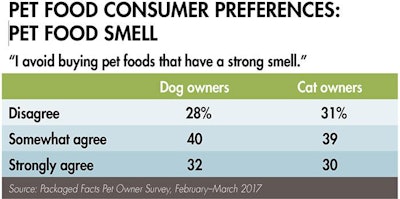
TABLE 3: Pet owners are not, as a general rule, fans of pet foods that are overly odorous: In this survey, the majority said that, to some degree, they avoid buying pet foods with a strong smell.
The odor of pet food is especially at issue because well over half (57–58 percent) of dog or cat owners feed their pets in the kitchen or family table area, and another third feed them in some other living area inside the home. Conversely, only about 17 percent of dog or cat owners feed their pets on a porch or outdoors and only about 12 percent feed in the garage.
Pet food odor avoidance, moreover, is one instance where the pet parenting trend can become a mixed blessing for pets: 61 percent of pet owners who strongly agree that pets are part of the family feed their pets in the kitchen or table area, where pet food odor is most at issue, compared with only 41 percent of those who disagree that pets are part of the family. Pets, nonetheless, both have their own preferences for kibble vs. canned, and have ways of making their preferences known.
EDITOR’S NOTE: A follow-up article in next month’s issue of Petfood Industry magazine will take up this topic from the pet preference point of view.
The latest pet food market trends
www.petfoodindustry.com/topics/222
More Packaged Facts research on the US pet market








